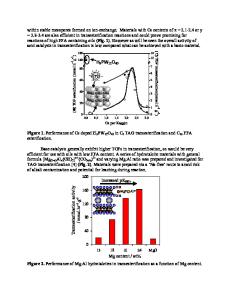Synthesis of hierarchical mesoporous zirconia fiber by using collagen fiber as a template
- PDF / 826,248 Bytes
- 6 Pages / 612 x 792 pts (letter) Page_size
- 31 Downloads / 338 Views
Xuepin Liaoa) and Xin Liu Department of Biomass Chemistry and Leather Engineering, Sichuan University, Chengdu 610065, People’s Republic of China
Bi Shib) Key Laboratory of Leather Chemistry and Engineering of Ministry of Education, Sichuan University, Chengdu 610065, People’s Republic of China (Received 25 April 2008; accepted 16 September 2008)
Ordered hierarchical mesoporous zirconia fiber was prepared by using collagen fiber as a template, and it was characterized by scanning electron microscopy, transmission electron microscopy, N2 adsorption techniques, x-ray photoelectron spectroscopy, x-ray diffraction, and elemental analysis. It was found that the zirconia fiber obtained is approximately 1–4 m in outer diameter and 0.5–1 mm in length, and the surface of the fiber exhibits unique corncob-like mesoporous morphology. This study indicates that collagen fiber, with hierarchical supermolecular structures, could be used as an ideal template to prepare porous metal oxide fibers.
I. INTRODUCTION
As one of the most important structural ceramic materials, zirconia has been widely studied for its promising applications in catalysts, adsorbents, biosensors, and fuel cells.1–8 In particular, ordered mesoporous zirconia is of high interest to researchers due to its high surface area, uniform framework, good photoluminescence property, and high catalysis activity.3,5,6 Many efforts have been devoted to designing and synthesizing mesoporous zirconia.9–14 Among them, the template method has been proven to be a versatile approach. The varieties of templates, such as surfactant,3,9,10 supermolecule,11 and block copolymer,12 have been used to synthesize mesoporous zirconia. However, the finding and research of a new template to synthesize mesoporous zirconia with a unique structure is still an attractive challenge. Collagen fiber, one of the most abundant biomass in the natural world, has a highly ordered supermolecular structure of collagen molecules.15–17 The collagen molecule, having a rodlike shape with 1.5 nm in diameter and 300 nm in length, is composed of three polypeptide chains with a helical structure (a right-handed triple he-
Address all correspondence to these authors. a) e-mail: [email protected] b) e-mail: [email protected] DOI: 10.1557/JMR.2008.0403 J. Mater. Res., Vol. 23, No. 12, Dec 2008
http://journals.cambridge.org
Downloaded: 04 Apr 2015
lix).15 The triple helices are staggered (on the fourth level of order) along their heliced long axis with a “gap” region corresponding to a length of 67 nm, which is usually called D-period.16 The collagen molecules aggregate through fibrillogenesis into microfibrils, which consist of four to eight collagen molecules, and further into fibrils. These collagen fibrils organize into fibers, which can form even larger fiber bundles.15 Therefore, collagen fiber is a promising candidate as a biotemplate to synthesize inorganic or organic-inorganic hybrid materials due to its hierarchical structure. Recently, silica- or goldcollagen/collagen-like fibrils and helices ha
Data Loading...











